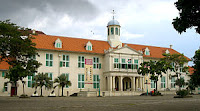 Jakarta Old Town
Jakarta Old TownKota (Indonesian: Kota Tua Jakarta), is a small area in Jakarta, Indonesia. It is also known as Old Jakarta, and Old Batavia (Dutch: Oud Batavia). It spans 1.3 square kilometres of North Jakarta and West Jakarta (Kelurahan Pinangsia, Taman Sari and Kelurahan Roa Malaka, Tambora). Kota is Indonesian word for "city", it was the reminiscent of the vicinity during colonial times in 16th century that the city was only within Batavia walled compound (today Kota), while the surrounding areas was only kampung (villages), orchards, and ricefields. The largely Chinese down town area of Glodok is a central part of Kota.
Dubbed "The Jewel of Asia" and "Queen of the East" in the 16th century by European sailors, Old Jakarta — or Batavia, as it was named by the Dutch — was once a center of commerce for the whole continent due to its strategic location and abundant resources.
* History
In 1526, Fatahillah, sent by Sultanate of Demak, invaded Hindu Pajajaran's port of Sunda Kelapa, after which he renamed it into Jayakarta. This town was only 15 hectare in size and had a typical Javanese harbour lay-out. In 1619 the VOC destroyed Jayakarta under the command of Jan Pieterszoon Coen. A year later the VOC built a new town named "Batavia" to honor Batavieren, the Dutch ancestors. This city was centered around the east bank of the Ciliwung river, around present day Fatahillah Square.
Inhabitants of Batavia are called "Batavianen", later known as "Betawi" people, the creole ethnic, the descendants of mixed various ethnicities that inhabited Batavia.
In 1635 the city expanded towards the west banks of Ciliwung, on the ruins of former Jayakarta. The city was designed in European Dutch style complete with a fortress (Kasteel Batavia), city wall, and canals. The city was arranged in several blocks separated by canals. The city of Batavia was completed in 1650. It became the headquarters of the VOC in the East Indies. The canals were filled up due to outbreaks of tropical diseases within the city walls because of poor sanitation. The city began to expand further south as epidemics in 1835 and 1870 forced more and more people to move out of the cramped city, to the Weltevreden area (now the area surrounding Merdeka Square). The city later became the administrative center of the Dutch East Indies. In 1942 during the Japanese occupation, Batavia was renamed Jakarta, and still serves as the capital city of Indonesia.
In 1972, the Governor of Jakarta, Ali Sadikin, issued a decree that officially made the Jakarta Kota area into a heritage site. The governor's decision was necessary in order to preserve the city's architectural roots — or at least what was left of it.
Despite the Governor's Decree, the old town remains neglected. Even though the majority was pleased just by the issuing of the decree, not enough was being done to protect and conserve the legacy from the Dutch colonial era.

No comments:
Post a Comment